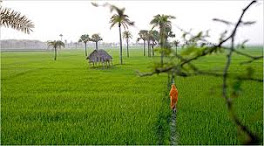Demographics of Bangladesh
This article is about the demographic features of the population of Bangladesh, including population density, ethnicity, education level, health of the populace, economic status, religious affiliations and other aspects of the population.
Demographics of Bangladesh
Population: 156,050,883 (July 2009 est.)[1]
Growth rate: 1.292% (2009 est.)
Birth rate: 24.68 births/1,000
population (2009 est.)
Death rate: 8 deaths/1,000
population (2009 est.)
Life expectancy: 60.25 years
–male: 57.57 years
–female: 63.03 years (2009 est.)
Fertility rate: 2.74 children born/woman (2009 est.)
Infant mortality rate: 59.02 deaths/1,000 live births
Age structure:
0-14 years: 34.6% (male 24,957,997/female 23,533,894)
15-64 years: 61.4% (male 47,862,774/female 45,917,674)
65-over: 4% (male 2,731,578/female 2,361,435) (2006 est.)
Sex ratio:
At birth: 1.04 male(s)/female (2009 est.)
Under 15: 1.01 male(s)/female
15-64 years: 0.9 male(s)/female
65-over: 0.94 male(s)/female
Nationality:
Nationality: noun: Bengali(s) adjective: Bangladeshi
Major ethnic: Bengali
Minor ethnic: Santhal, Chakma, Garo, Bihari, Oraon, Munda, Rohingya
Language:
Official: Bengali
Spoken: Bengali, Chittagonian, Sylheti, Tribal languages and English
Bangladesh is ethnically homogeneous. Indeed, its name derives from the Bengali ethno-linguistic group, which comprises 98% of the population. Bengalis, who also predominate in the West Bengal province of India, are one of the most populous ethnic groups in the world. Variations in Bengali culture and language do exist of course. There are many dialects of Bengali spoken throughout the region. The dialect spoken by those in Chittagong and Sylhet are particularly distinctive. In 2009 the population was estimated at 156 million. Religiously, about 90% of Bangladeshis are Muslims and the remainder are mostly Hindus.
Most of the demographic statistics below are from the CIA World Factbook, unless otherwise indicated.
Population
The mid-2009 estimate for total population was 156,050,883 which ranks Bangladesh 7th in the world (CIA).
Collection of sources
Naturally there is some degree of uncertainty about the population, especially in a developing country such as Bangladesh with a high level of illiteracy and rural population. For instance, in 2005 there was not a consensus on which of Bangladesh and Russia had the larger population. The UN's ESA ranked Russia 7th in the world and Bangladesh 8th. However, the CIA World Factbook ranked Bangladesh 7th and Russia 8th in the same year. The point is now moot as the population of Russia is in decline while that of Bangladesh is growing.
The following table lists various recent estimates of the population. The baseline for population studies on Bangladesh is the official census which is conducted every 10 years, the last being in 2001.
SourceYearPopulation (millions)National Census[2]1991112National Census[2]2001129UN Population Fund[3]2003150UN Dept Economic and Social Affairs[4]2005142US State Dept[5]2005144Population Reference Bureau[6]2005144CIA World FactBook[7]2006147UN Population Fund[8]2006144CIA World FactBook[9]2007150UN[10]2007159
Genetics
Bangladesh has the world's highest frequency of the M form of mitochondrial DNA. This genetic variant spans many continents, and is the single most common mtDNA haplogroup in Asia.[11] In Bangladesh it represents about 83% of maternal lineages.[12]
Population growth rate
Bangladesh had one of the highest rates of population growth in the world in the 1960s and 1970's. Since then however it has seen a marked reduction in its total fertility rate. Over a period of three decades it dropped from 6.2 to 3.2, according to UNDP figures from 2003.
Demographic evolution of the territory of Bangladesh (1900-2010).
Pop. growth rate:1.292% (2009 est.)
country comparison to the world: 104
Birth rate:24.68 births/1,000 population (2009 est.)
country comparison to the world: 71
Death rate:8 deaths/1,000 population (2009 est.)
country comparison to the world: 82
Net migration rate:-2.53 migrant(s)/1,000 population (2009 est.)
country comparison to the world: 145
Total fertility rate:2.74 children born/woman (2009 est.)
country comparison to the world: 82
Urban and rural
Like its neighbor India, Bangladesh remains a nation of villages. In spite of the sprawling mega-city of Dhaka, the vast majority live in rural areas.
Urban population: 27% of total population (2009 est.)
Rate of urbanization: 3.5% annual rate of change (2005-2010 est.)
Health
Infant mortality rate
Total: 59.02 deaths/1,000 live births
country comparison to the world: 39
Male: 66.12 deaths/1,000 live births
Female: 51.64 deaths/1,000 live births (2009 est.)
HIV/AIDS
Adult prevalence rate: less than 0.1% (2001 est.)
county comparison to the world: 102
People living with HIV/AIDS: 12,000 (2007 est.)
county comparison to the world: 85
Deaths: fewer than 500 (2007 est.)
country comparison to the world: 8s
Major infectious diseases
Degree of risk: high
Food or waterborne diseases: bacterial and protozoal diarrhea, hepatitis A and E, and typhoid fever
Vectorborne diseases: dengue fever and malaria are high risks in some locations
Water contact disease: leptospirosis
Animal contact disease: rabies (2005)
Religion
The largest religion of Bangladesh is Islam where according to the Bangladesh Bureau of Statistics 89.7% are Muslims, 9.2% are Hindus and the remaining include Buddhism, Christianity and others.[18]
According the 2001 Census, the largest religion in Bangladesh was Islam with over 130 million Muslims at a percentage of nearly 90%, making it the majority religion in the country, the second largest was Hinduism with nearly 9% followed by others, which includes Buddhists, Christians and Animists.[19] The majority of the Muslims are Sunni consisting of 95% of the Muslim population, and the remaining are Shi'a and other sects.[citation needed]
Hindus constitute 9.2% of the population. In 1961, they were 18.5% of the population, but their population declined significantly during the Bangladesh Liberation War due to the 1971 Bangladesh atrocities carried out by the Pakistan Army. As a result, millions of Hindus fled to India and their population in Bangladesh fell to 13.5% by 1974. Since then, the Hindu population has not grown as much as the Muslim population.
Education
Literacy
Definition: age 15 and over can read and write
Total population: 43.1%
Male: 53.9%
Female: 31.8% (2003 est.)
Education expenditures
2.7% of GDP (2005)
country comparison to the world: 151
Subscribe to:
Post Comments (Atom)







No comments:
Post a Comment